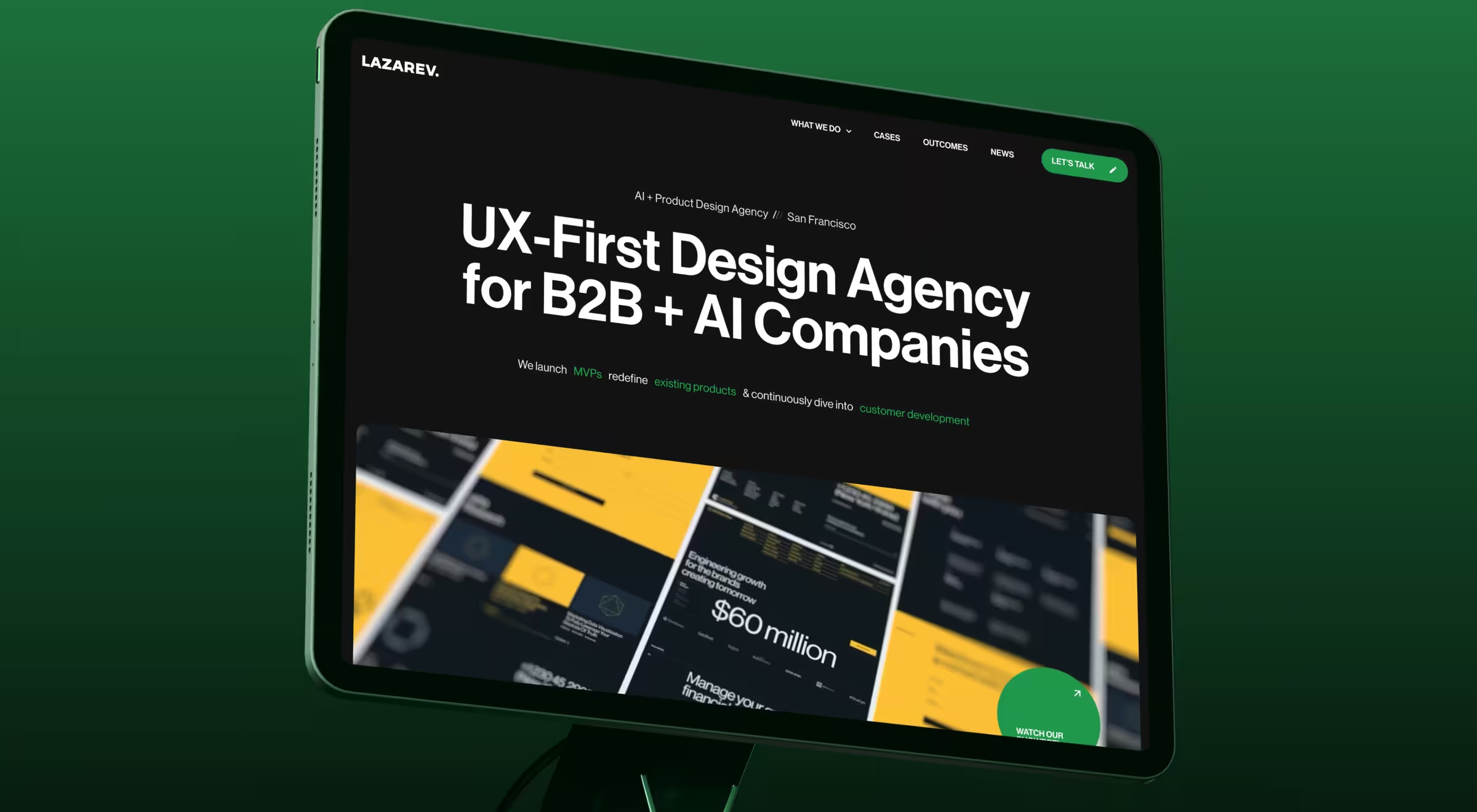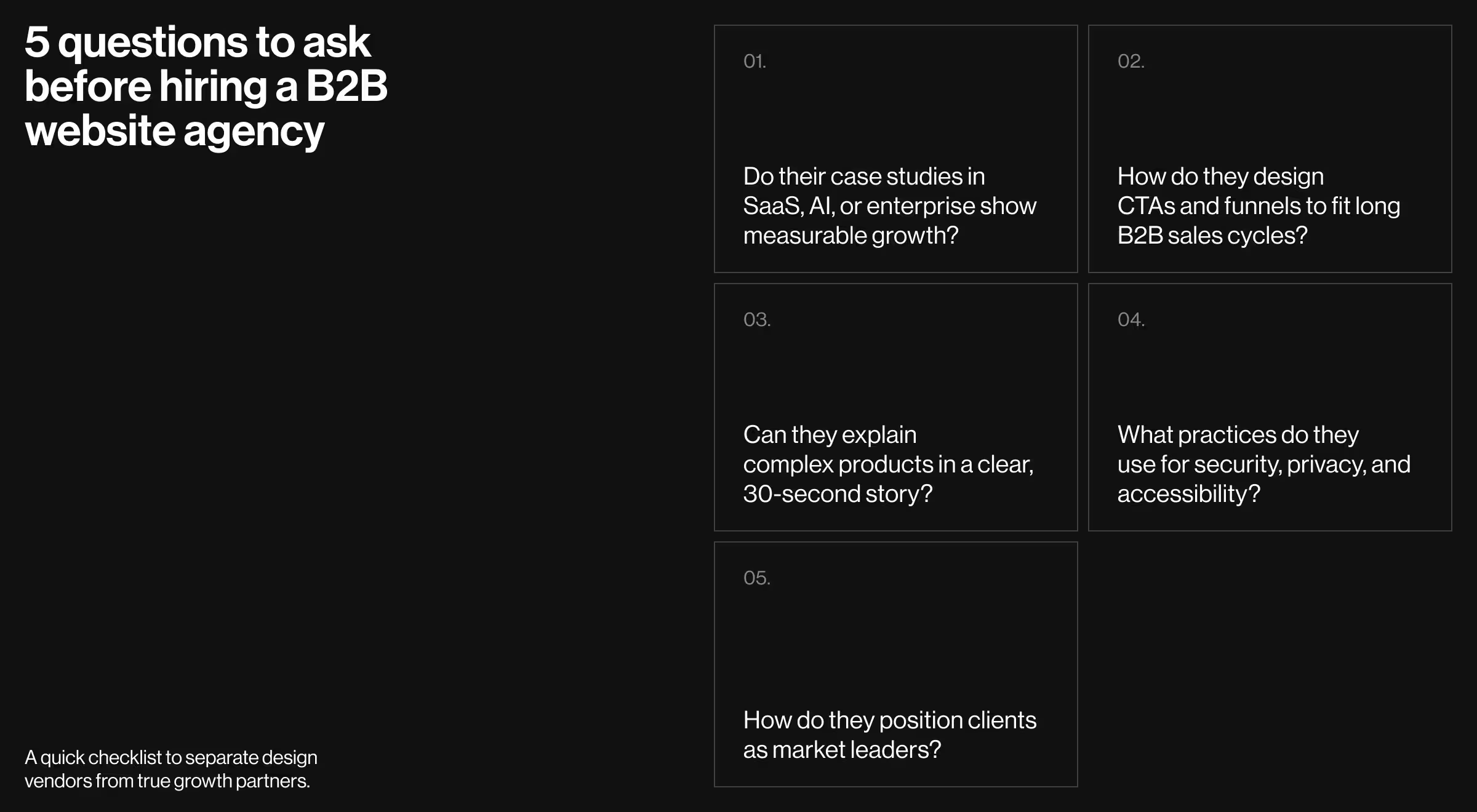What if your B2B website is actively costing you deals?
In an industry obsessed with lead funnels and sales cycles, it’s easy to overlook the first impression that actually matters: your digital presence. Here’s the tension. B2B buyers now behave like B2C consumers. They research independently, form snap judgments, and are ready to ghost brands that feel even a beat behind.
In this article, our expert designers handpicked some of the best B2B web design agencies and prepared a breakdown of the core services they offer. These insights will be invaluable if you’re seeking to outmaneuver competitors in an oversaturated market.
Key takeaways
- Experience design wins deals. B2B buyers judge you against the best online experiences.
- Core services matter. Expect UX strategy, custom design, scalable CMS, conversion flows, and brand identity.
- Performance is trust. Fast, optimized sites reduce bounce rates and build confidence at critical decision points.
11 top design agencies specializing in B2B websites 2026
B2B buyers don’t just compare you to your direct competitors. They measure you against the best digital experiences they’ve ever encountered.
That’s why partnering with an agency that builds brand strategy around experience design is the difference between winning a seven-figure deal and losing credibility at the very first click.
Below, we’ve spotlighted 11 leading B2B web design agencies with a proven ability to translate intricate business models into digital experiences built for conversion.
Here’s a side-by-side look at who they are, what they excel at, and the projects that showcase their impact.
The table above gives you a bird’s-eye view of how these B2B web design agencies stack up. But facts alone only scratch the surface. What really matters is how each agency thinks and the processes they follow.
In the sections below, we dive deeper into their strengths, specialties, and the types of companies they serve best.
Lazarev.agency, best design company for B2B platform redesign

- Location: San Francisco, CA (serving globally)
- Hourly Rate: $100–$149
- Best for: Tech companies, AI-driven products, and enterprises seeking strategic UX.
Lazarev.agency is an award winning design agency and strategic web design partner that has embedded AI innovation into its projects since 2017. Today, it’s recognized for rewriting the rules of B2B web design. Renowned for AI-powered UX and conversion-focused digital products, the agency has helped clients raise over $500M and scale their businesses worldwide.
👉 Explore our Clutch profile and portfolio
DD.NYC
- Location: New York, NY
- Hourly Rate: $150–$199
- Best for: Fast-growth startups and luxury brands seeking sharp branding with high quality design.
DD.NYC blends branding and UI/UX frameworks into smart digital presences. Their projects often focus on functionality, which makes them a go-to partner for fintech, crypto, and lifestyle business players.
👉 Explore the company's Clutch profile
45RPM
- Location: Takoma Park, MD
- Hourly Rate: $100–$149
- Best for: Corporations and mid-market SaaS firms looking for integrated web and marketing execution.
45RPM stands out for its exquisite brand storytelling. They specialize in building marketing-focused websites for SaaS and service-based enterprises.
👉 Explore the company's Clutch profile
UPQODE
- Location: Nashville, TN (with international presence)
- Hourly Rate: $100–$149
- Best for: Businesses that want scalable WordPress and B2B websites built fast without sacrificing design.
UPQODE combines technical agility with a strong creative process. Known for sleek, modern designs, they focus heavily on custom web design and development.
👉 Explore the company's Clutch profile
League Design Agency
- Location: New York, NY
- Hourly Rate: $50–$99
- Best for: Startups and Web3 companies revamping their brand identity and creating digital products that stand out.
League Design Agency is praised for its one-of-a-kind design language. They create digital products and branding systems that give companies a competitive edge in innovative markets, including SaaS and blockchain.
👉 Explore the company's Clutch profile
Baunfire
- Location: San Jose, CA
- Hourly Rate: $150–$199
- Best for: Silicon Valley startups and enterprise B2B firms that need design polished to investor-grade quality.
Baunfire has been crafting high-performance websites for global brands like Google and Nike for over 2 decades. Their work focuses on user-centric digital experiences for ambitious tech players.
👉 Explore the company's Clutch profile
Coherent Solutions
- Location: Minneapolis, MN (global delivery)
- Hourly Rate: $50–$99
- Best for: Enterprises and large B2B organizations seeking robust custom platforms at scale.
Coherent Solutions is a full-service digital engineering powerhouse. With a team of 1,000+, they deliver diverse large-scale digital platforms, cloud applications, and custom solutions for web design.
👉 Explore the company's Clutch profile
Studio Fox Design
- Location: Dallas, TX
- Hourly Rate: $100–$149
- Best for: Small to mid-sized businesses that need creative design and agile execution.
Studio Fox Design crafts high-impact web solutions for early-stage businesses as well as nonprofits. Their strength lies in custom design that helps smaller B2B players punch above their weight in the digital scene.
👉 Explore the company's Clutch profile
Storm Brain
- Location: San Diego, CA
- Hourly Rate: $150–$199
- Best for: Companies that want a partner blending web design with an ongoing marketing strategy.
Storm Brain takes a holistic approach, combining UX/UI with digital marketing services to deliver growth-focused web solutions. Their B2B work emphasizes creative flair and clear communication.
👉 Explore the company's Clutch profile
CyberOptik
- Location: Elmhurst, IL
- Hourly Rate: $100–$149
- Best for: Professional service providers and manufacturing firms that need a clear web design focused on lead generation.
CyberOptik is a veteran player in B2B web design. The team specializes in conversion-focused websites for law firms, manufacturers, and local enterprises. Their strength lies in usability and cost-effective builds.
👉 Explore the company's Clutch profile
Usman Group
- Location: Denver, CO
- Hourly Rate: $150–$199
- Best for: Mid-market and enterprise organizations that need research-driven digital strategy with design.
Usman Group is strategy-led. The team combines UX research, stakeholder workshops, and design execution into full digital transformations. With clients like Harvard Business School and Chicago Booth, they’re trusted for projects where precision and business logic matter most.
👉 Explore the company's Clutch profile
What the best B2B web design and development agencies really deliver
The best B2B web design and development agencies boost trust and shorten sales cycles. If you’re serious about competing in the B2B market, here are the services that matter:
- UX strategy and market research. In B2B, sales don’t depend on a single decision-maker. They involve multiple stakeholders and long evaluation cycles. That’s why your design strategy must guide every UX persona through intuitive flows to tackle hesitation and keep potential customers progressing toward a decision.
- Custom web design. Templates undermine credibility. Conversely, custom design signals expertise and differentiation.
- Website development and content management systems (CMSs). Behind the front end, your site needs a secure backbone. Marketing teams must be able to update content with ease.
- Conversion architecture. Every page should sell. Calls to action (CTAs), gated content, and lead funnels must be engineered to turn visitors into sales-ready leads.
- Performance optimization. In B2B e-commerce, speed and credibility impact revenue. A slow site erodes trust, while missing proof points stall decisions. The best agencies design mobile-first experiences to keep bounce rates low and build confidence where hesitation strikes.
- Branding and visual identity. A consistent brand system reinforces trust at every interaction. It makes your business feel like the safer, smarter choice.
How to choose among the best B2B product design companies in America

Selecting the best B2B website agency for technology company could be challenging. Tech buyers aren’t impulsive. They evaluate multiple vendors and expect a website that communicates technical depth.
Here’s what to look for when deciding on your next strategic web design partnership:
- Proven track record in tech. Case studies in SaaS, AI, or enterprise software that show real impact on adoption, funding, or user growth.
- Conversion-driven design. CTAs and lead generation structures engineered to shorten long B2B sales cycles.
- Clear storytelling. Complex products translated into sharp narratives that resonate with buyers and investors.
- Security. Privacy, accessibility, and regulatory standards built into the foundation.
- Brand positioning expertise. Design that frames your company as the go-to partner in a crowded market.
B2B website conversion benchmarks: what great looks like
When evaluating agencies, most B2B leaders ask the same question: “What results should I expect?”
The truth is — high-performing B2B websites don’t just look polished; they convert with precision. Below are benchmark metrics that reveal what separates an average corporate site from one that closes deals daily.
B2B vs B2C web design: what really changes
It’s tempting to think all great websites follow the same playbook — fast, beautiful, conversion-driven. But the psychology behind B2B and B2C design couldn’t be more different. The stakes, decision dynamics, and emotional triggers vary entirely. Understanding these contrasts is what turns a website from a digital brochure into a deal-closing machine.
B2C design sells experiences. B2B design sells trust.
In the B2B world, every color, layout, and word must align with credibility. Motion and flair still matter but they serve persuasion, not entertainment. The best B2B websites feel like decision-enablement tools: guiding users, answering objections, and earning confidence at every scroll.
B2B web design process: from discovery to launch
A successful B2B website is built through a structured process designed to reduce uncertainty, align stakeholders, and create measurable business impact. Each stage follows a logical sequence that connects research, design, testing, and optimization.
1. Research and stakeholder mapping
The process begins with a deep understanding of the business context and decision ecosystem.
In B2B, purchasing decisions involve multiple stakeholders — marketing leads, technical experts, financial officers, and executives.
Research focuses on:
- Identifying all buyer roles and their influence on the decision process.
- Analyzing pain points, motivations, and objections that shape conversion.
- Reviewing competitors and market positioning.
The outcome of this stage is a clear buyer model that informs the design strategy.
🔍 Curious how research shapes winning products? Explore Lazarev.agency UX expert’s breakdown of market research vs UX research — how each informs strategy, validates ideas, and drives product success from two different angles.
2. UX strategy and information architecture
Once insights are collected, the next step is to translate them into a structured experience.
UX strategy defines how information flows across the site and how users move through each stage of awareness, evaluation, and decision.
Information architecture organizes pages and navigation to ensure:
- Logical hierarchy of content.
- Easy access to key proof points and product details.
- Reduced cognitive load through clear pathways.
This stage defines how complex offers become simple, scannable, and persuasive.
3. UI and brand integration
UI design and brand systems transform structure into credibility.
In B2B, design is a signal of trust. Consistency, clarity, and restraint communicate reliability to decision-makers evaluating high-value partnerships.
Core focus areas include:
- Applying a cohesive visual identity that reinforces authority.
- Maintaining readability and accessibility across devices.
- Aligning color, typography, and layout with brand positioning.
The outcome is an interface that looks refined and feels reliable.
🔍 Discover how a structured UI design process template can streamline collaboration and boost team output. See how Lazarev.agency’s design frameworks improved productivity by 2.4 hours per employee daily and how the same approach can scale efficiency across your product team.
4. Prototype and test
Testing ensures design logic holds up in real user conditions.
Interactive UX prototypes are shared with representative users to validate assumptions about clarity, navigation, and message hierarchy.
This stage helps:
- Identify usability issues before development.
- Measure comprehension and flow efficiency.
- Gather feedback to refine interaction patterns and microcopy.
The goal is to confirm that the design supports both business goals and user logic.
5. Launch and optimize
After launch, optimization becomes a continuous process.
Analytics, user behavior data, and A/B testing reveal how visitors interact with the site and where friction remains.
Ongoing improvements focus on:
- Enhancing conversion paths.
- Adjusting content for better engagement.
- Updating SEO and performance metrics.
This final phase turns the website into a self-learning system that evolves with buyer expectations and business growth.
Summing up, the B2B web design process follows a reasoning-driven structure.
- It begins with understanding user intent and business logic.
- It translates insight into information architecture and interface design.
- It validates through testing and evolves through analytics.
This ensures every design decision connects back to one objective helping complex B2B buyers move confidently toward action.
How AI is changing B2B web design workflows
AI has quietly become the new creative director in B2B web design shaping not only how websites look, but how they think, adapt, and sell. For brands competing in long, logic-heavy buying cycles, the shift is profound: design decisions are no longer driven solely by intuition but by intelligence that learns from user behavior in real time.
Predictive UX
Traditional analytics show what happened. Predictive UX shows what’s about to happen.
AI now analyzes behavioral data to forecast where users will hesitate, drop off, or convert — allowing teams to preempt friction before it costs a deal. For B2B platforms juggling multiple buyer personas and decision stages, this means every interaction can be dynamically tuned to the next logical step in the sales journey.
As Kyrylo Lazariev, CEO and Founder of Lazarev.agency, mentions: “Without sharp UX, AI is just a shiny tool nobody wants to use. With it, AI becomes invisible guiding decisions, powering products, and scaling growth in ways competitors can’t catch.”
Generative design and personalization at scale
Generative AI is rewriting how design systems evolve. Instead of static layouts, websites can now generate adaptive components changing CTAs, messaging, and visuals based on user intent, industry, or buying stage.
A B2B buyer from an enterprise finance firm might see compliance proof and ROI metrics; a startup founder might see scalability and integration content. The layout learns. The tone adjusts. The interface personalizes itself.
AI-powered heatmaps and behavior tracking
Conversion rate optimization is no longer about static A/B tests. AI heatmaps synthesize thousands of interactions — cursor paths, scroll depth, dwell time — into predictive insights that reveal not just what users do, but why.
For agencies, this means design updates can be driven by data confidence. The result: faster iteration loops, higher accuracy, and fewer wasted sprints.
Conversational AI: the new front door of B2B websites
In 2025, every B2B website should have at least one conversational touchpoint. Whether it’s a chatbot that answers product queries with contextual intelligence or a voice-enabled assistant that guides users through documentation, AI interfaces are replacing traditional “Contact Us” funnels. These systems qualify leads, surface relevant content, and capture data that enriches CRM pipelines.
Where Lazarev.agency leads the change
At Lazarev.agency, AI innovation is a design layer embedded in every project. Our AI & Digital Transformation division builds products where intelligence amplifies human intent rather than replacing it.
Our approach covers every angle of intelligent design:
- UX for AI/ML — crafting intuitive, trustworthy interfaces for AI-driven products.
- AI conversational design — building chat and voice systems that turn complex tools into natural experiences.
- Generative AI consulting — using GenAI to automate design exploration and content adaptation.
- Predictive & anticipatory UX — designing systems that act before users ask.
This philosophy runs through our AI & ML solutions — from AI sales MVPs that secured $1M in funding to AI-powered SaaS platforms that raised $3.8M. The results prove a simple point: when AI and UX design work together, transformation stops being theoretical and becomes measurable growth.
The future: intelligence as a design material
In the next wave of B2B design, AI won’t just analyze data, it will co-design experiences, shaping every headline, animation, and layout in response to context. Websites will behave less like static pages and more like living systems that learn from every interaction.
The agencies that master this — the ones who design how intelligence behaves — will define the future of B2B growth.
Stop losing B2B deals online and build your advantage with AI UX design by Lazarev.agency
Your website is your strongest sales weapon. The agencies listed above prove that when experience design is baked into strategy, it accelerates adoption and builds trust faster.
Start with assessing your current site against the standards outlined here:
- Does it guide multiple stakeholders?
- Does it tell a clear and compelling story of your product?
- Does it turn interest into a pipeline without unnecessary hurdles?
If the answer is no, you’re already losing ground.
At Lazarev.agency, we help B2B tech companies turn that gap into an opportunity. We’ve designed platforms that raised hundreds of millions in funding and repositioned enterprises as market leaders.
The best time to fix your digital presence was yesterday. The second best is now. Get in touch with us today to make a lasting difference to your business.





























.webp)



















